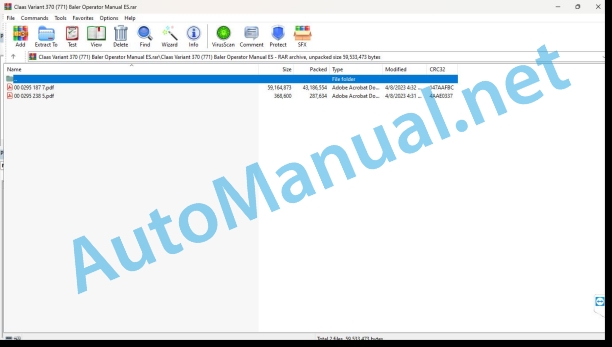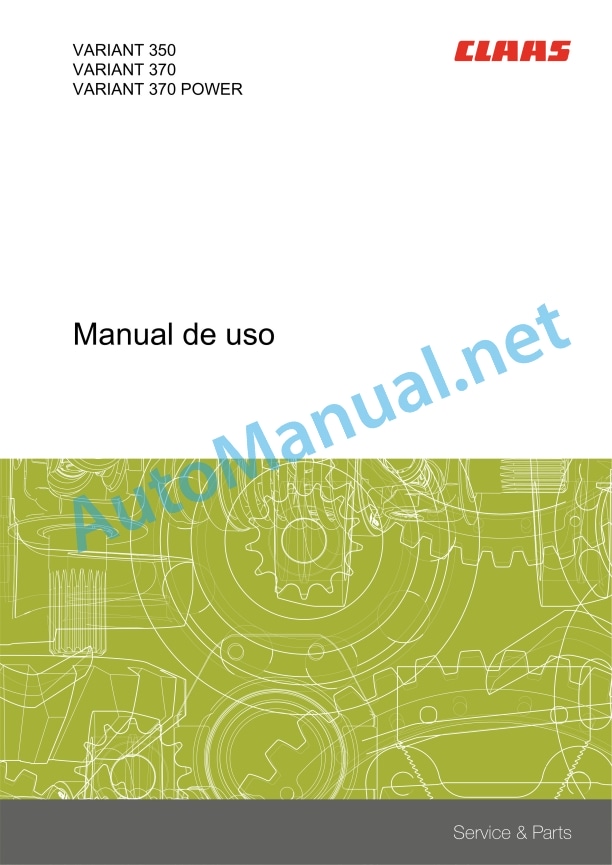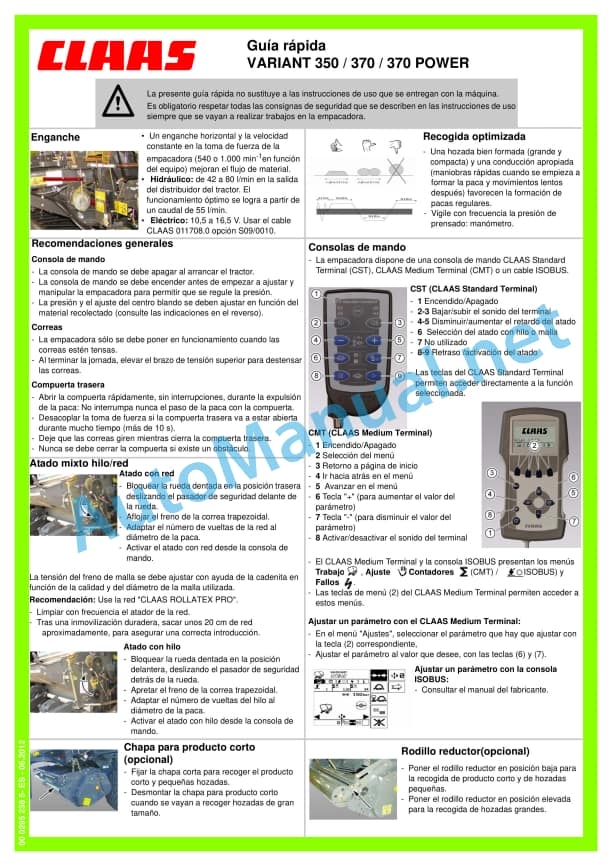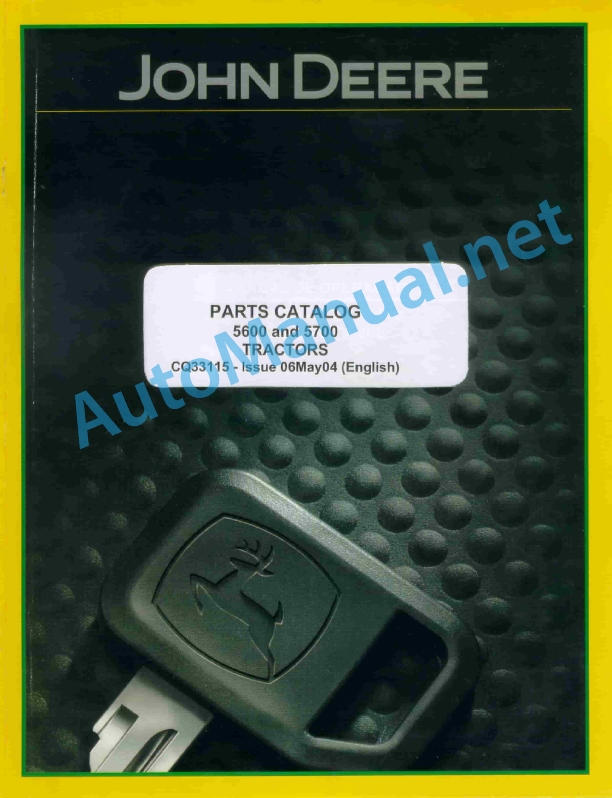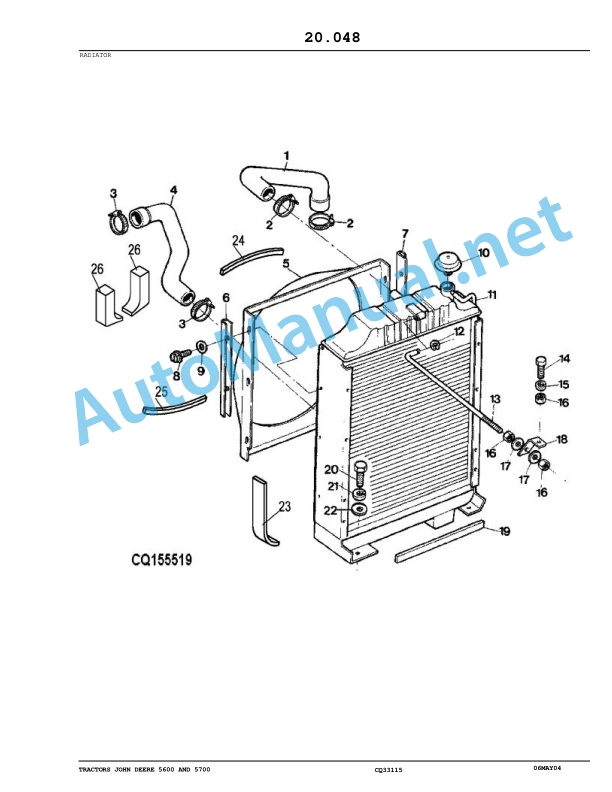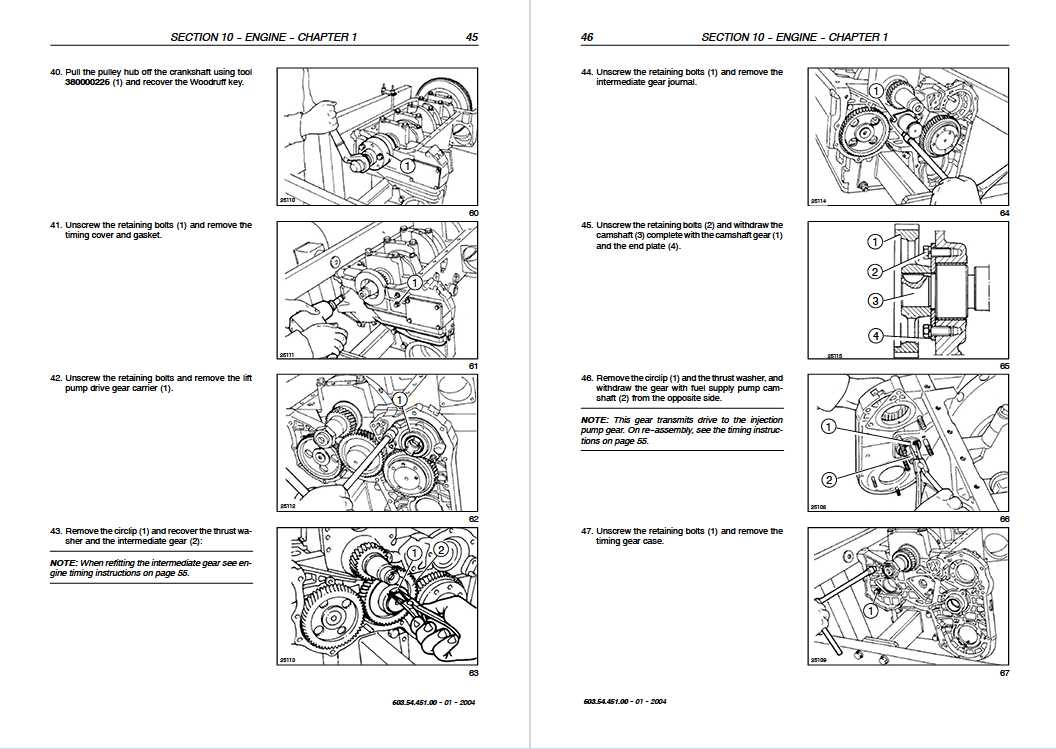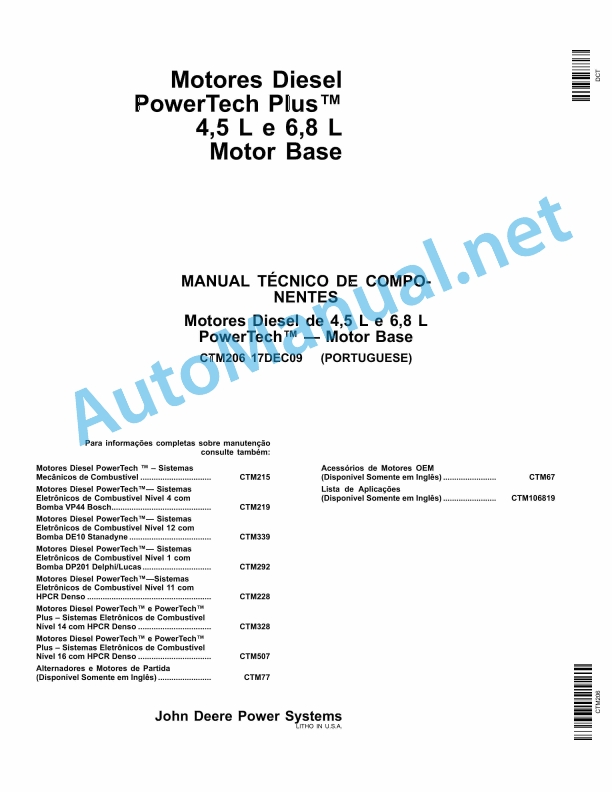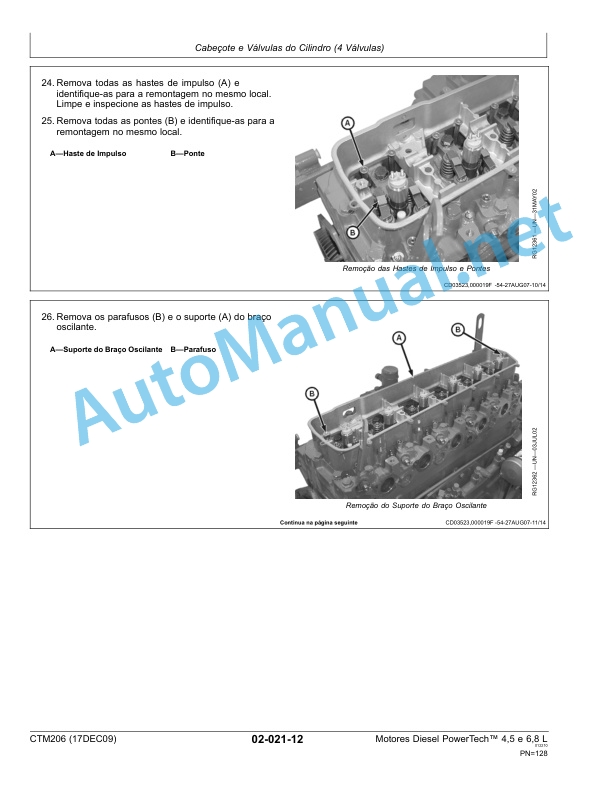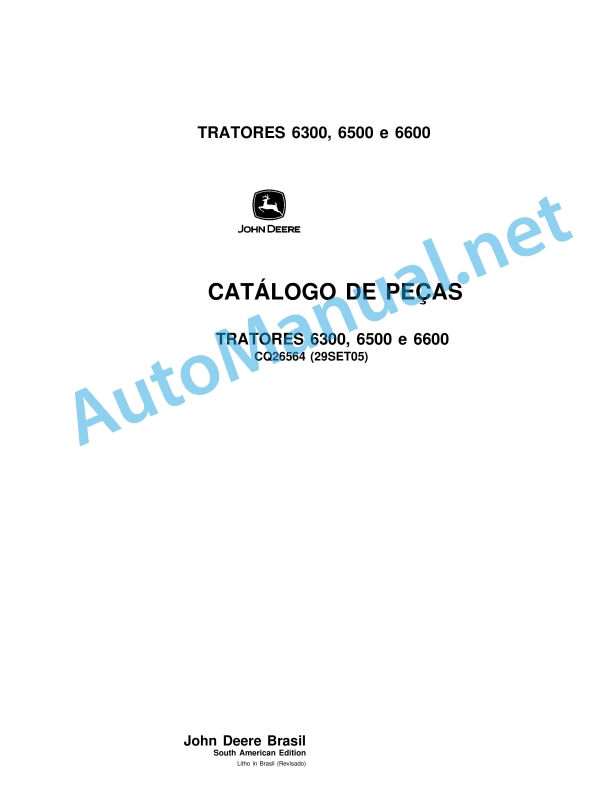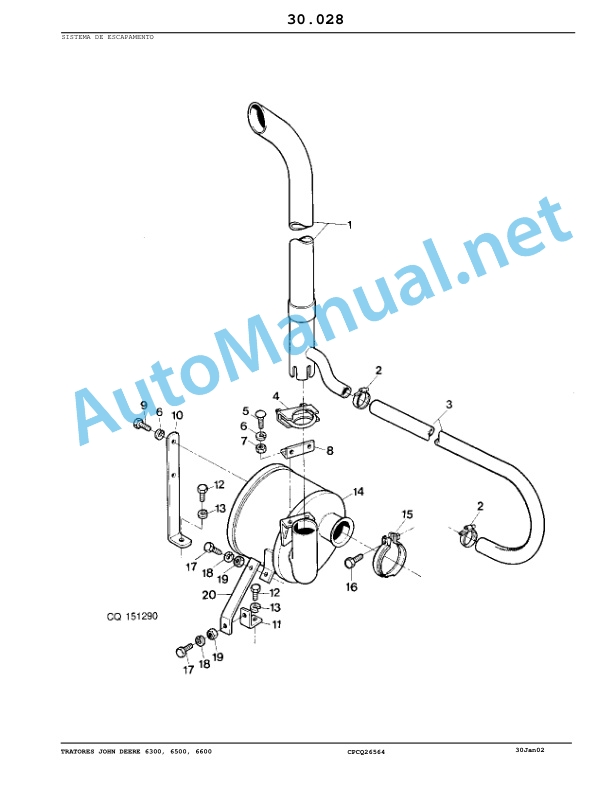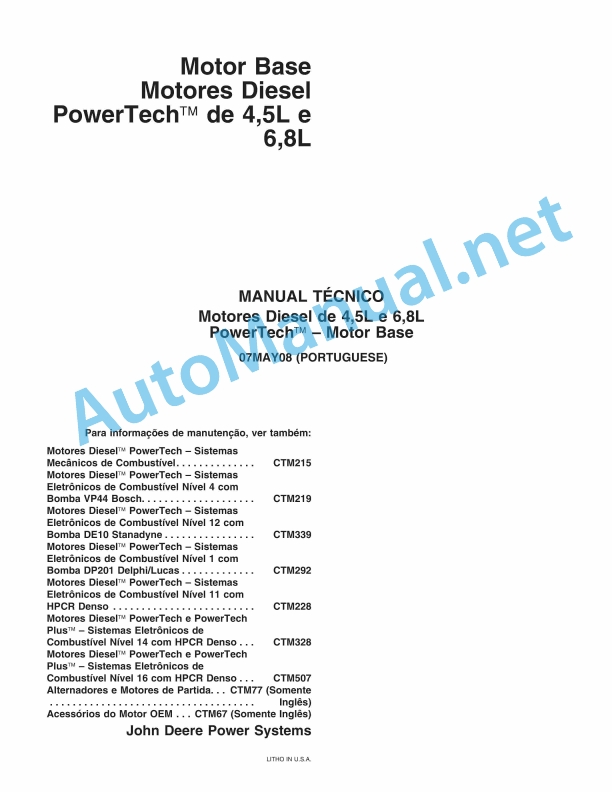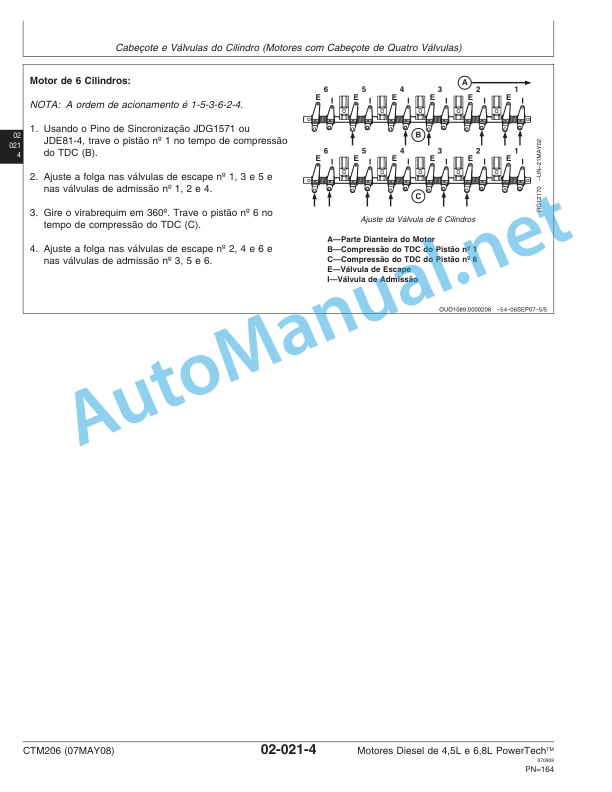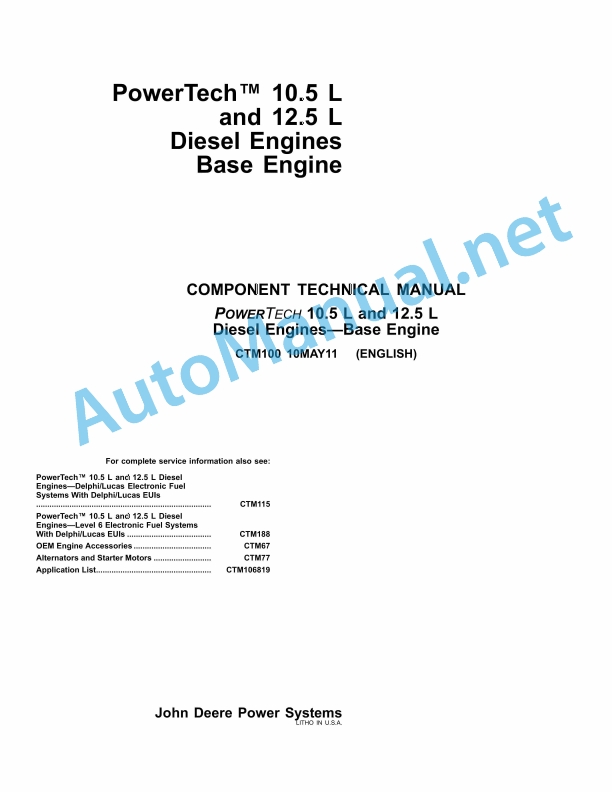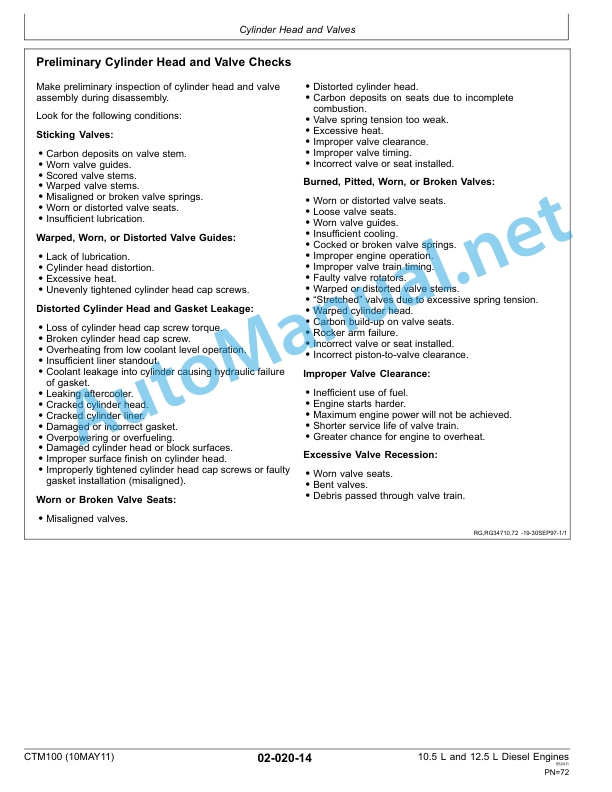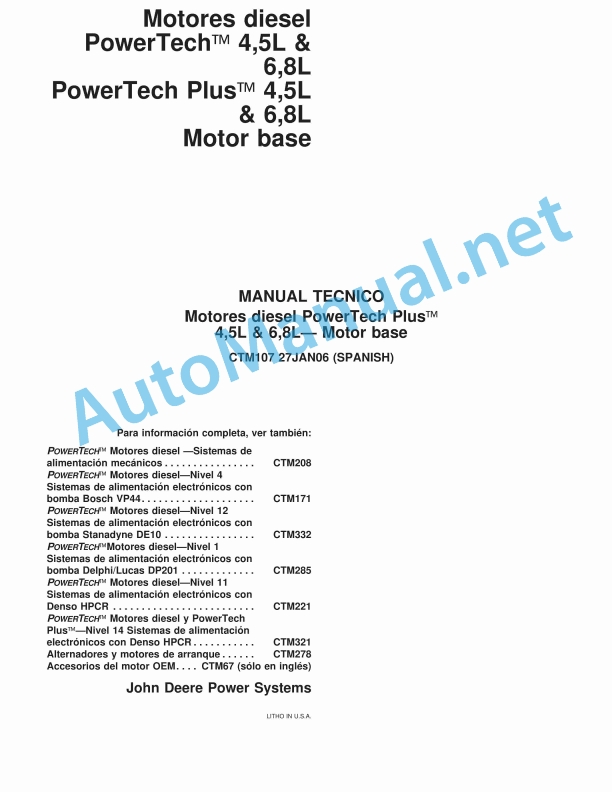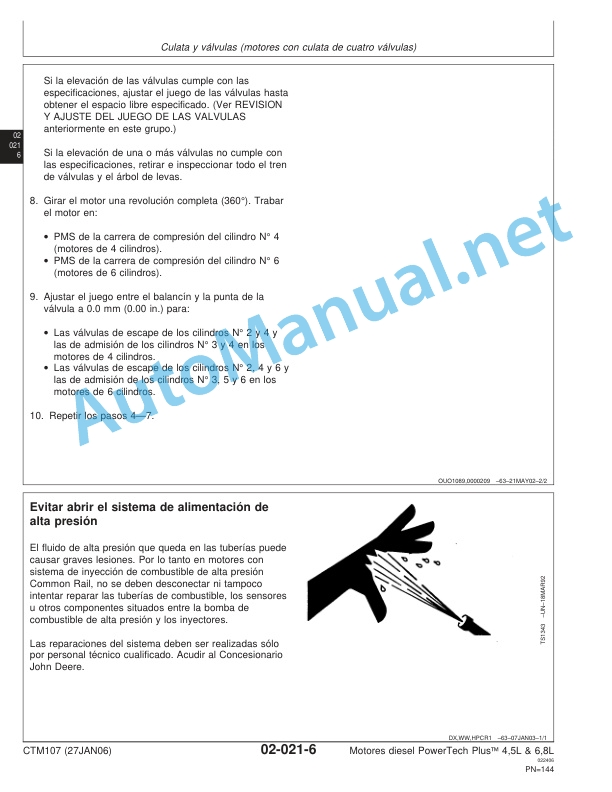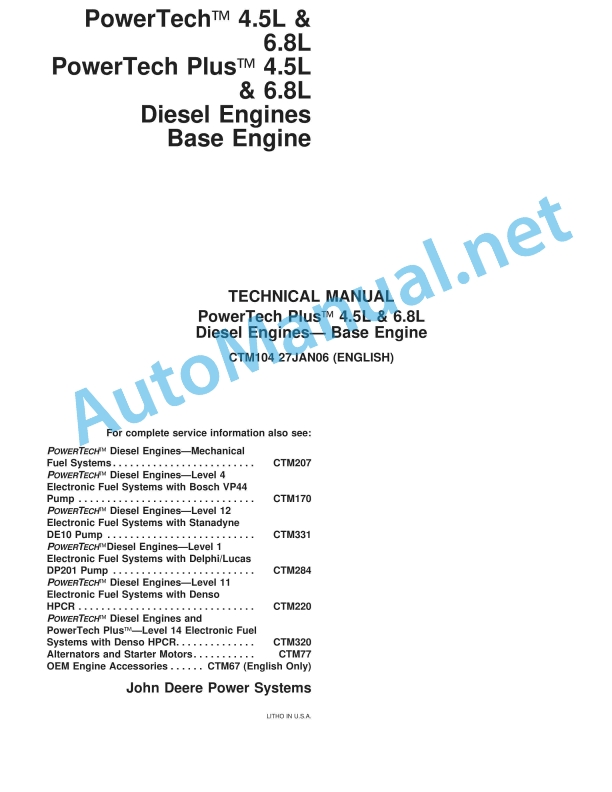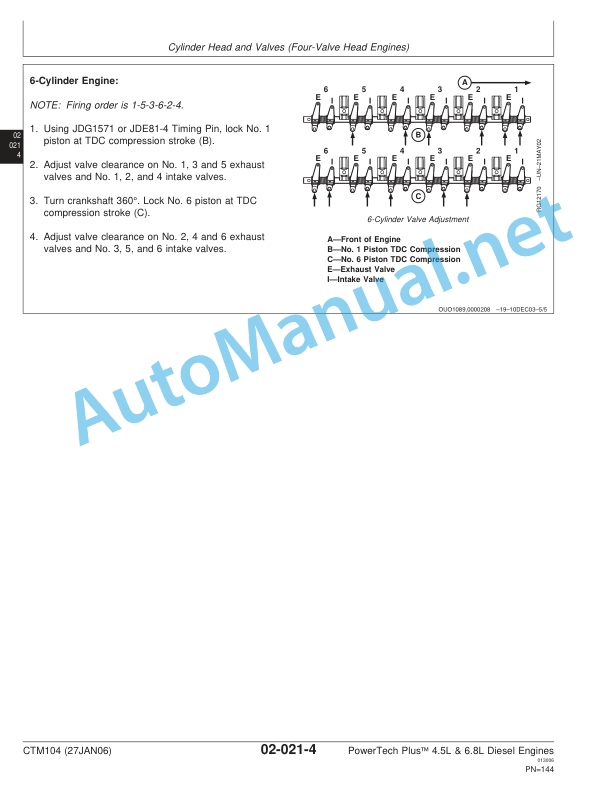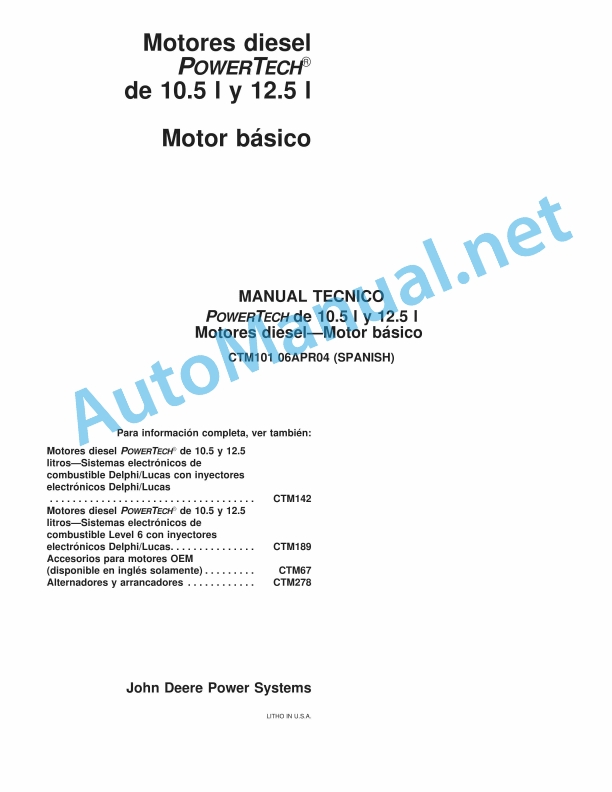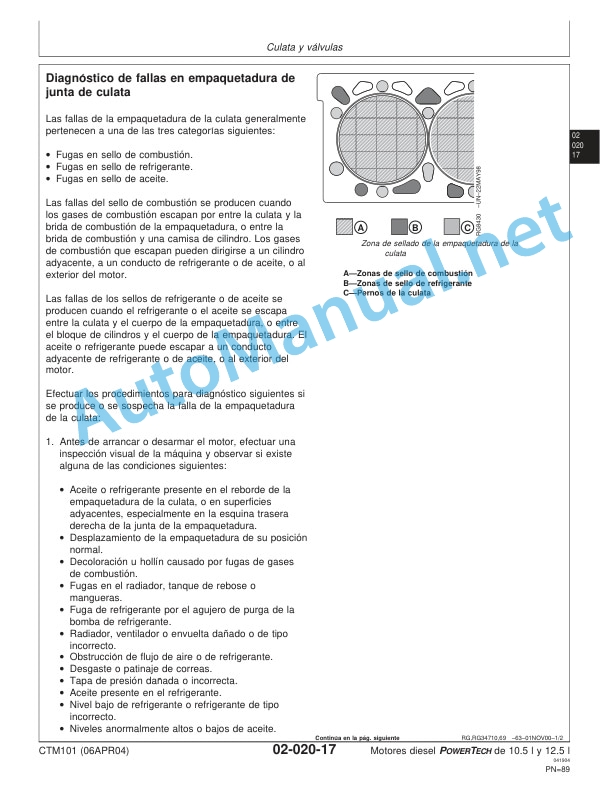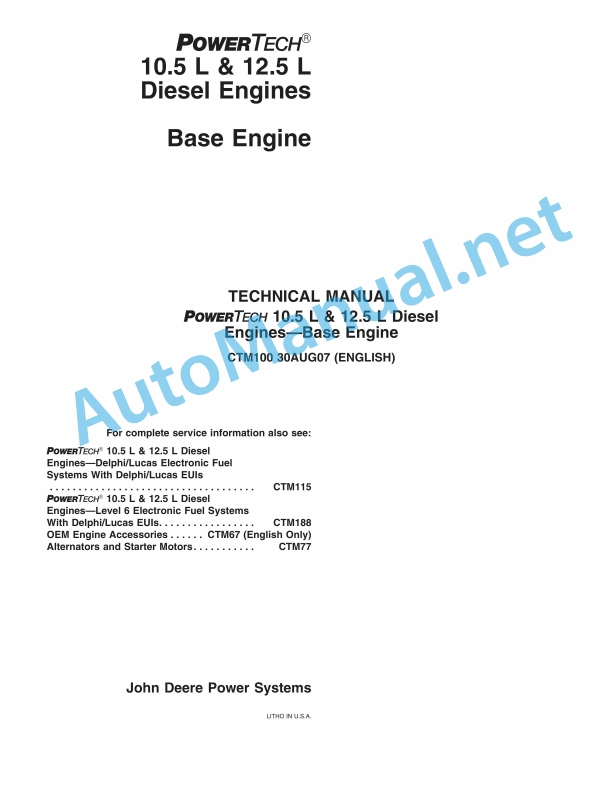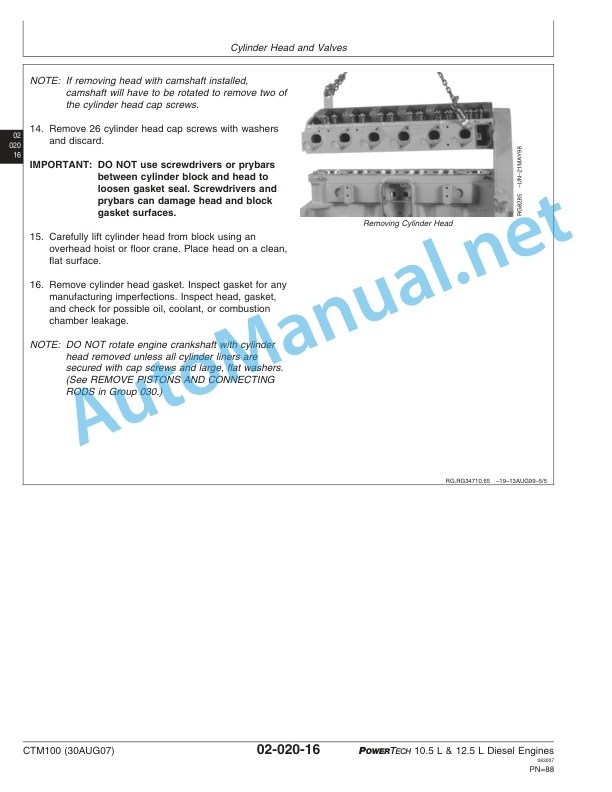Claas Variant 370 (771) Baler Operator Manual ES
$50.00
- Model: Variant 370 (771) Baler
- Type Of Manual: Operator Manual
- Language: ES
- Format: PDF(s)
- Size: 41.5 MB
File List:
00 0295 187 7.pdf
00 0295 238 5.pdf
00 0295 187 7.pdf:
VARIANT 350VARIANT 370VARIANT 370 POWER
1 Regarding this instruction manual
1.1 General data
1.1.1 Application of this user manual
1.1.2 About this user manual
1.1.3 Technical characteristics
2 Security
2.1 General data
2.1.1 General information
2.1.2 Authorized use
2.1.3 Reasonably foreseeable misuse
2.1.4 Highway driving
2.1.5 Symbols applicable to danger indications
2.1.6 Safety regulations
2.1.7 Accident prevention
2.1.8 Waste disposal
2.1.9 Residual risks
2.2 Graphic danger symbols
2.2.1 Description
2.2.2 Location of safety stickers
2.3 Safety equipment
2.3.1 Signal lighting
2.3.2 Reflective equipment
2.3.3 Surety
2.3.4 Chocks
2.3.5 Holding cable (machine not equipped with brake and usable in France)
2.3.6 Tailgate lock
2.3.7 Locking the pick-up
2.3.8 Fire extinguisher
2.3.9 Main box outlet protection without twine tying
3 Machine Description
3.1 Existing models
3.1.1 Designation of machines
3.2 Overview and functions
3.2.1 Left side
3.2.2 Right side
3.2.3 Roller identification
3.3 Work and service positions
3.3.1 General information
3.3.2 Front of the baler
3.4 Identification plate and serial number
3.4.1 Spare parts and technical information
3.4.2 Position of the nameplates
3.4.3 Machine nameplate
3.4.4 Rudder nameplate
3.5 General operating principle
3.5.1 Bale pressing cycle
3.6 Control terminal
3.6.1 Control terminal
3.6.2 ISOBUS connection
3.7 Transmission and drive
3.7.1 Transmission
3.7.2 Drive
3.7.3 Drive Chains
VARIANT 350 and VARIANT 370
VARIANT 370 POWER
3.7.4 Pick-up drive
3.7.5 Rotor drive
3.8 Reception of the harvest
3.8.1 Pick-up
3.8.2 Compactor
3.8.3 Short straw planks (optional)
3.8.4 Reducer roller (optional)
3.9 Power set
3.9.1 Rotor
3.10 Pressing system
3.10.1 Pressing chamber and belts
3.10.2 Loose core
3.10.3 Pressing chamber filling indicator (option)
3.11 Tying system
3.11.1 Tying types and processes
3.11.2 Standard tying
3.11.3 Tying with thread
3.11.4 Tying with mesh
3.11.5 Bundling introduction canvas
3.11.6 Tying process
3.11.7 Yarn/mesh box
3.12 Unloading bales
3.12.1 Bale exit ramp
3.13 Lubrication system
3.13.1 Automatic chain lubrication
3.14 Greasing system
3.14.1 Manual centralized lubrication (optional)
3.15 Hydraulic system
3.15.1 Active hydraulics
3.16 Equipment
3.16.1 Ladder
3.16.2 Stirrup
3.16.3 Pressure gauge
3.16.4 Indicator light
3.16.5 Mechanical counter
3.16.6 Module
4 Control and display instruments
4.1 CLAAS STANDARD TERMINAL
4.1.1 Presentation
4.1.2 Key identification
4.1.3 Presentation of visualizations
4.2 CLAAS Medium Terminal
4.2.1 Presentation
4.2.2 Screen
4.2.3 Key identification
4.2.4 Home page
4.2.5 Description of the menus
4.3 ISOBUS Terminal
4.3.1 Presentation
4.3.2 General information
4.3.3 Screen
4.3.4 Description of the menus Using the ISOBUS terminal
5 Technical data
5.1 Baler
5.1.1 General information
5.1.2 Dimensions
5.1.3 Weight
5.1.4 Hooking
5.1.5 Cardan shaft
5.1.6 Feeding and pressing
5.1.7 Tying device
5.1.8 Wheels
5.1.9 Hydraulic circuit
5.1.10 Screw tightening torques
5.1.11 Greasing and lubrication
5.1.12 Sound levels
5.2 Safety devices
5.2.1 Security screw
5.2.2 Torque limiter
5.3 Tractor
5.3.1 Required power
5.3.2 Hooking
5.3.3 PTO
5.3.4 Hydraulic circuit and oil
5.3.5 Electrical connections
5.3.6 Hydraulic connections
6 Preparation of the machine
6.1 General data
6.1.1 First commissioning
6.1.2 Equipment control
6.2 Cardan shaft
6.2.1 Safety regulations
6.2.2 Cardan shaft adjustment
6.2.3 Adaptation of the cardan shaft length
6.2.4 Transformation kit, 8 grooves (optional)
6.2.5 Placing the cardan shaft
6.3 Trailer support
6.3.1 Recommendations
6.3.2 Types of fixing
6.3.3 Adaptation of the fork hitch/oscillating bar hitch
6.3.4 Placing the cardan shaft
6.3.5 Holding cable (machine not equipped with brake and usable in France)
6.4 Hydraulic connections
6.4.1 Identification of hydraulic hoses
6.4.2 Connection to tractor double-acting distributors
6.5 Electrical connections
6.5.1 Marking of electrical cables
6.5.2 Lighting
6.5.3 Battery cable (optional)
6.5.4 Power supply to the baler and CLAAS Standard Terminal
6.5.5 Power supply to the baler and CLAAS Medium Terminal
6.5.6 Baler power supply with ISOBUS cable
6.6 Tying with thread
6.6.1 Yarn quality
6.6.2 Preparation
6.6.3 Thread tensioner adjustment
6.6.4 Placing the coils
6.6.5 Thread passage with standard tying
6.6.6 Selection of tying with thread (depending on equipment)
6.7 Tying with mesh
6.7.1 Preparation
6.7.2 Mesh installation
Adjusting the lateral position of the mesh roll
6.7.3 Selection of mesh tying (depending on equipment)
6.8 Machine loading
6.8.1 Baler stowage
6.8.2 Lifting rings
6.8.3 Elevation
7 Management
7.1 General data
7.1.1 Baler user
7.1.2 Opening of hatches and crankcases
Side gates
Opening of the side doors
Closing the side doors
Left pick-up crankcase
7.2 Movements with the baler
7.2.1 Equipment control
7.2.2 Preparations for transportation
7.2.3 Road travel
7.2.4 Arrival at the field
7.2.5 Moving around the field
7.2.6 Parking
7.3 Before each use
7.3.1 Reminders
7.3.2 Cardan shaft
7.3.3 Baler maintenance
7.4 Commissioning in the field
7.4.1 Usage tips
7.4.2 Commissioning of the machine
7.5 Specific use
7.5.1 Use with pre-hay and silage
VARIANT 350 and VARIANT 370
VARIANT 350 and VARIANT 370/370 POWER
Tailgate Strap Guides
7.6 Pick-up
7.6.1 Important
7.6.2 Pick-up wheels
7.6.3 Pick-up height
7.6.4 Reducer roller
7.7 Tied
7.7.1 Reminders
7.7.2 Selection of tying with thread or mesh (depending on equipment)
7.7.3 Setting the number of thread turns with standard tying
7.7.4 Adjustment of the number of loops of mesh with standard tying
7.7.5 Mesh roll brake adjustment
7.8 Bale parameters
7.8.1 Bale diameter settings
7.8.2 Adjustments with dry material (straw or hay)
7.8.3 Settings for pre-haying and ensiling
Pressure settings
VARIANT 350 and VARIANT 370
VARIANT 370 POWER
Diameter settings
Loose core parameter:
Baler equipped with CLAAS Standard Terminal:
Baler equipped with CLAAS Medium Terminal or an ISOBUS terminal:
7.9 CLAAS STANDARD TERMINAL
7.9.1 Setting bale parameters
Tying time settings
7.9.2 Pressing process – tying
7.9.3 Pressing pressure
7.9.4 Manual activation of the tying process
7.9.5 Manual delay of the tying process
7.9.6 Faults
7.10 CLAAS Medium Terminal
7.10.1 Sound
7.10.2 Counters Menu
7.10.3 Setting bale parameters
Pressure settings
Tying time settings
7.10.4 Pressing process – tying
7.10.5 Pressing pressure
7.10.6 Manual activation of the tying process
7.10.7 Tying delay
7.10.8 Pressing chamber filling indicator (optional)
7.10.9 Faults
7.11 ISOBUS Terminal
7.11.1 Selection and adjustments of the work
7.11.2 Setting bale parameters
Pressure settings
Tying time settings
7.11.3 Pressing – tying process
7.11.4 Pressing pressure
7.11.5 Manual activation of the tying process
7.11.6 Tying delay
7.11.7 Pressing chamber filling indicator (optional)
7.11.8 Maintenance indicator reset
7.11.9 Faults
7.12 Unclogging the baler
7.12.1 How to avoid traffic jams?
7.12.2 Safety regulations
7.12.3 Unjamming the pick-up
7.12.4 Unclogging the baler
7.13 After use
7.13.1 Reminders
7.13.2 Baler protection
7.13.3 Daily checks
7.13.4 Daily cleaning
7.13.5 Disconnecting the baler
8 Incident and solution
8.1 General data
8.1.1 Sensors
8.2 Hydraulic system
8.2.1 Hydraulic block
8.2.2 Pressing pressure
8.2.3 Rotor
8.2.4 Drive
8.2.5 Tailgate
8.3 CLAAS STANDARD TERMINAL
8.3.1 Pressing pressure
8.3.2 Oversize
8.3.3 Bale exit
8.3.4 Thread knife
8.4 CLAAS Medium Terminal
8.4.1 Pressing pressure
8.4.2 Oversize
8.4.3 Bale exit
8.4.4 Thread knife
8.5 ISOBUS terminal
8.5.1 Pressing pressure
8.5.2 Oversize
8.5.3 Bale exit
8.5.4 Thread knife
8.6 Tied
8.6.1 Tying with thread
8.6.2 Tying with mesh
8.7 Lubrication system
8.7.1 Origin of problems
8.7.2 Troubleshooting
8.8 Greasing system
8.8.1 Origin of problems
8.8.2 Troubleshooting
8.9 Other functions
8.9.1 General functions
9 Maintenance
9.1 General maintenance instructions
9.1.1 Maintenance and safety tips
9.1.2 Wheels and tires
9.1.3 Hydraulic circuit
9.1.4 Endless belts
9.1.5 V-belt
9.1.6 Chains
9.1.7 Pressing and tying device
9.1.8 Cardan shaft
9.1.9 Hitch
9.1.10 Protection devices
9.1.11 Screws and nuts
9.1.12 Lubricants and greasing
9.1.13 Inductive sensors
9.1.14 Welding work
9.1.15 Spare parts
9.2 Maintenance tables
9.2.1 Maintenance operations before collection
9.2.2 Maintenance operations after the first 10 hours of service
9.2.3 Maintenance operations after the first 50 hours of service
9.2.4 Maintenance operations every 8 hours of service or every day
9.2.5 Maintenance operations every 50 hours of service
9.2.6 Maintenance operations every 100 hours of service
9.2.7 Maintenance operations every 250 hours of service
9.2.8 Annual maintenance operations or every 500 hours of service
9.2.9 Maintenance operations when necessary
9.3 Lubricant tables
9.3.1 Lubricants
9.4 Greasing scheme
9.4.1 Important
9.4.2 Greasing intervals
9.4.3 Greasing points – 8 h
9.4.4 Grease points – 50 h
9.4.5 Greasing points – 100 h
9.5 Gear maintenance operations
9.5.1 Drive box 540 rpm
9.5.2 Drive box 1 000 rpm
9.5.3 Cardan shaft security screw
9.6 Axle and wheel maintenance operations
9.6.1 Tire check
9.6.2 Wheel tightening check
9.6.3 Replacing the wheels
9.6.4 Wheel hub
9.7 Hitch device maintenance operations
9.7.1 Fixing the hitch hole and rudder
9.8 Hydraulic system maintenance operations
9.8.1 Filter
9.9 Pick-up maintenance operations
9.9.1 Pick-up
9.9.2 Pick-up security screw
9.10 Maintenance operations on the power supply unit
9.10.1 Rotor clutch
9.11 Pressing chamber maintenance operations
9.11.1 Loosening
9.11.2 Wear check
9.11.3 Repair
9.11.4 Replacing a belt
9.11.5 Replacing a complete set
9.11.6 Centering of endless belts
9.11.7 Bundling introduction canvas
9.11.8 Roller No. 1
9.11.9 Roller No. 2
9.11.10 Roller No. 5
9.11.11 Roller No. 7
9.11.12 Drive springs
9.12 Tying maintenance operations
9.12.1 Tying with thread
9.12.2 Tying with mesh
9.13 Bale unloading maintenance operations
9.13.1 Bale exit ramp
9.14 Lubrication system maintenance operations
9.14.1 Chain lubrication
9.15 Maintenance operations of the lubrication system
9.15.1 Manual lubrication
9.15.2 Centralized manual lubrication (optional)
9.16 Bodywork maintenance operations
9.16.1 Thread compartment (depending on equipment)
9.16.2 Fire extinguisher (optional)
9.16.3 Inductive damper sensor
9.17 Hibernation
9.17.1 General information
9.17.2 Cleaning
9.17.3 Cleaning surfaces with stickers
9.17.4 Greasing
9.17.5 Maintenance
9.17.6 Storage
10 Decommissioning and waste disposal
10.1 General data
10.1.1 Decommissioning and waste disposal
11 EC declaration of conformity
11.1 General data
11.1.1 Declaration of conformity for CE
11.1.2 Declaration of conformity for CE
John Deere Repair Technical Manual PDF
John Deere Parts Catalog PDF
John Deere Tractors 6300, 6500, and 6600 Parts Catalog CQ26564 (29SET05) Portuguese
John Deere Repair Technical Manual PDF
John Deere Diesel Engines PowerTech 4.5L and 6.8L – Motor Base Technical Manual 07MAY08 Portuguese
John Deere Repair Technical Manual PDF
John Deere PowerTech M 10.5 L and 12.5 L Diesel Engines COMPONENT TECHNICAL MANUAL CTM100 10MAY11
John Deere Repair Technical Manual PDF
John Deere Repair Technical Manual PDF
John Deere Repair Technical Manual PDF
John Deere Repair Technical Manual PDF

